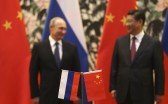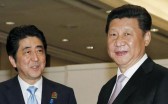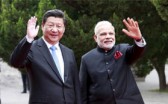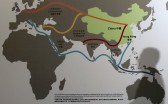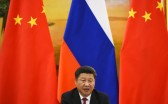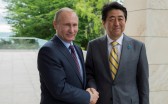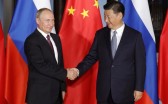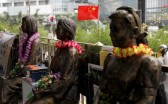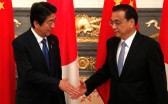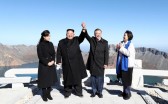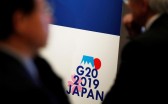In September 2013, President Xi Jinping, while visiting Kazakhstan, announced the new “Silk Road Economic Belt” initiative. In October 2013, during his visit to Indonesia, Xi proposed to establish the “Twenty-First Century Maritime Silk Road” that connects China with Southeast Asia. From late 2013 to mid-2014, the Chinese government steadily promoted the “the Belt, the Road” initiative in various venues:1 a high-level periphery diplomacy work meeting; a joint study by the Ministry of Foreign Affairs, Ministry of Commerce, and National Development and Research Council; the Boao Forum for Asia; the Sino-Arabic Summit; and domestic mobilization.2 Momentum was steadily building as many observers expected China’s resources to suffice to make this initiative a reality.
In the beginning, the Chinese scholarly communities had limited knowledge of the “the Belt, the Road” initiative, except for a few closely placed in government think tanks. Those who were aware of “the Belt, the Road” were unanimously supportive and enthusiastic about its potential. Outside China, knowledge of “the Belt, the Road” proposals became evident only after China’s inauguration of a USD 40 billion Silk Road Fund in November 2014. Yet, a mixture of concern and skepticism dominated external observers’ evaluations and partly explained the US government lobbying against the Asian Infrastructure International Bank (AIIB), which the Chinese launched as an arm of “the Belt, the Road” initiative.
Compared to external skepticism, Chinese scholars and think tankers were zealous about “the Belt, the Road” initiative and made this policy the most studied subject in China in 2015: thousands of articles were published; universities and think tanks established centers and programs on it; local officials competed to have their areas listed on the proposed blueprints; sectors, including arts and literature, came up with plans to participate in the new initiative. Yet, skepticism quietly surfaced in China, driven partly by skepticism from outsiders and partly due to a sense that “things are going too fast.”3
In the summer of 2015, at a high-level Chinese international relations forum exclusively devoted to discussion of the initiative, caution and skepticism were clear. Participants included over 60 first-tier experts and a ministerial official from the State Council, who offered a thirty-minute keynote address to launch the forum. Surprisingly, two-thirds of the keynote speech explained risks and challenges facing the advancement of “the Belt, the Road” abroad and cautioned specialists against high expectations. The conference to follow produced more doubts about the initiative than supportive voices. Such skepticism grew more serious in late 2015, with deepening difficulties in the Chinese domestic economy and structural reforms.4
Overwhelmed with a sense of risks and uncertainties, serious scholars have yet to research the significance of “the Belt, the Road” initiative, the inauguration of which is significant in at least two respects. First, it is a regional framework advanced by China, in contrast to previous regional institutions led by the United States and the Association of Southeast Asian Nations (ASEAN). Second, “the Belt, the Road” initiative was established under development projects in interior China, South Asia, and Central Asia. Its implementation can potentially impact the heretofore undeveloped regions in Asia, challenges and uncertainties notwithstanding.
China’s New Leadership in Asian Regionalism
Regionalism in Asia has developed in different waves and achieved the most progress since 1997.5 The United States promoted the Asia-Pacific Economic Cooperation (APEC) in 1989. China joined in 1991. In 1994, Southeast Asian countries launched the ASEAN Regional Forum to integrate China into a multilateral framework that helps to minimize the security threat presented by its rise. China grudgingly joined in 1995. The Asian financial crisis in 1997 and 1998 increased cohesion among East Asian nations. With the economic rise of China, the gravity of East Asian regionalism gradually moved from maritime Southeast Asia to Northeast Asia, as captured in Kent Calder and Min Ye’s concept the “Shanghai Circle.”
China’s new gravitational pull, however, intensified geostrategic competition in maritime Asia, with Japan’s unease and America’s opposition. When the East Asia Summit was launched in 2005, membership was expanded, against Chinese wishes, to include Australia, New Zealand, and India. By 2010, the United States also had gained membership and, more or less, ended the era of regionalism that centered on East Asian nations, a formula preferred by China. Against this backdrop, China’s pursuit of regionalism was redirected.
ASEAN-led regionalism featured soft institutionalism and had unbinding conditions. It was useful to stabilize political tensions among members; yet, its actual rule-making capability was limited. From 2008, the United States began to pursue the Trans-Pacific Partnership (TPP); an initiative started by Singapore, Brunei, New Zealand, and Chile and insisted on establishing high-standard economic rules in the Asia-Pacific. Excluding China, TPP progressed rapidly. When Japan applied for membership in 2011, TPP was projected to be the largest trade bloc in the world once the negotiations were complete.
China’s apprehension and resistance to TPP were profound; yet, it had few viable options. Joining TPP would be unrealistic—by all indications, the US negotiators would prefer to complete TPP negotiations among allies and partners before possible expansion to China—and self-destructive, for many restrictive terms pertained to state-owned enterprises, the environment, and labor clauses that are not compatible with China’s economic interests.
China’s “the Belt, the Road” initiative was launched against this background and gained momentum as it appeared to offer a viable alternative to counter the US-led TPP. It has characteristics that differ from those of previous regionalism and TPP. First, geographic coverage is distinct. “The Belt, the Road” covers areas that were largely left uncovered by previous Asian regionalism. Second, development goals dominate. Instead of economic rule making or policy networking, infrastructure projects and industrial parks are the main contents. Third, rules are implicit, and its principles are largely commercial. In short, these differences and China’s new leadership in Asian regionalism stand in the forefront, deserving to be studied.
Grassroots Globalization and Asia’s Lagging Areas
Asia as a whole has offered the longest and most abundant industrial catch-up stories in the world. The first generation of Asia’s industrializers started with the Japanese, who rebuilt their war-torn nation into the world’s second largest economy after WWII. South Korea, Taiwan, Singapore, and Hong Kong—the four tigers—followed suit and rapidly leapfrogged into industrialized economies in mere decades. China’s economic rise constituted the second generation of Asia’s catch-up history. I found that the “Chinese miracle” was deeply embedded in the earlier Asian developers, most prominently in the return of entrepreneurs from Hong Kong and Taiwan.6 Given its size and population, the scale of China’s economic rise and potential impact is greater than the earlier Asian industrializers. In 2009, China became the world’s largest exporter, and in 2015, it became the world’s largest economy in Purchasing Power Parity (PPP) terms.
Leaving these rankings aside, the Chinese economy is unique in two ways. First, it remains a rising, developing country and has a whole range of sectors and industries: labor-intensive manufacturing, state-led infrastructure and heavy industries, and a host of medium-range manufacturing and exporting in machinery, electronics, and services. These industries are all included in projects related to “the Belt, the Road” initiative and can potentially find different niches in the targeted countries. Second, different from advanced countries, China’s economy features, as many noted, strong central planners, proactive local governments, and state banks and companies.7 Yet, more importantly, China has abundant grassroots entrepreneurs eager and willing to explore markets in underdeveloped regions. Compared to investors from advanced societies, the Chinese grassroots globalizers lived through poverty and built fortunes in still undeveloped places. Private entrepreneurs in coastal Zhejiang have gone to interior China, Africa, Central and South China to seek commercial opportunities since the 1990s. In short, for undeveloped areas in “the Belt, the Road,” government-led infrastructure development and localized grassroots globalizers may be a better fit than Western-led globalization, which operates on the basis of arms-length advising and financing.
The Real Danger Lies in Insufficient Study of “the Belt, the Road”
Skepticism would be a welcomed antidote to the zealous pursuit of “the Belt, the Road” in China. Skepticism is unhelpful when it prevents serious scholars from studying how to manage its uncertainties and fulfill its positive potential. On the one hand, this initiative may undermine commitments to existing cooperative frameworks. For example, how will the AIIB, the financial arm of “the Belt, the Road,” affect the Asia Development Bank’s operations in the region? How will the initiative influence China’s response and possible engagement with the TPP framework? Will the Chinese-led regionalism, if not linked with existing frameworks, divide regionalism in Asia into halves?
These dangers need to be studied more fully, and more regional actors need to be brought into positive conversations and implementation. Promoters of “the Belt, the Road” have a responsibility to develop linkages with existing, even competitive, regional frameworks. Stakeholders of the other frameworks also need to understand “the Belt, the Road” as a new initiative that may deepen the region’s cooperation and development and ought to work together to minimize the potential risks of the new initiative. The stakes are too high to leave the new Chinese initiative buried in controversies and debates. Serious studies and rigorous research are in demand.
1.The names for the two proposals have evolved since late 2013. In May 2015, the Chinese government set the official English name for the initiative as “the Belt, the Road.” Outside China, the initiative is better known as “One Belt, One Road.” In this essay, I use “the Belt, the Road” to refer to these two proposals.
2.For a detailed account of activities promoting “the Belt, the Road” initiative, see Min Ye, “Competing Cooperation in Asia Pacific: TPP, RCEP, and New Silk Road,” Asian Security 10, no. 3 (2015): 1-19.
3.Li Ziguo, “Yidaiyilu, Fengxian Buke Bucha,” Liaowang, March 18, 2015.
4.Skepticism is quite clear in the author’s more than 20 conversations with Chinese specialists at universities and think tanks.
5.For an introduction to the different periods in Asian regionalism, see Kent Calder and Min Ye, The Making of Northeast Asia (Stanford, CA: Stanford University Press, 2010).
6.Min Ye, Diasporas and Foreign Direct Investment in China and India (Cambridge: Cambridge University Press, 2014).
7.Barry Naughton and Kellee Tsai, State Capitalism, Institutional Adaptation, and the Chinese Miracle (Cambridge: Cambridge University Press, 2015).

